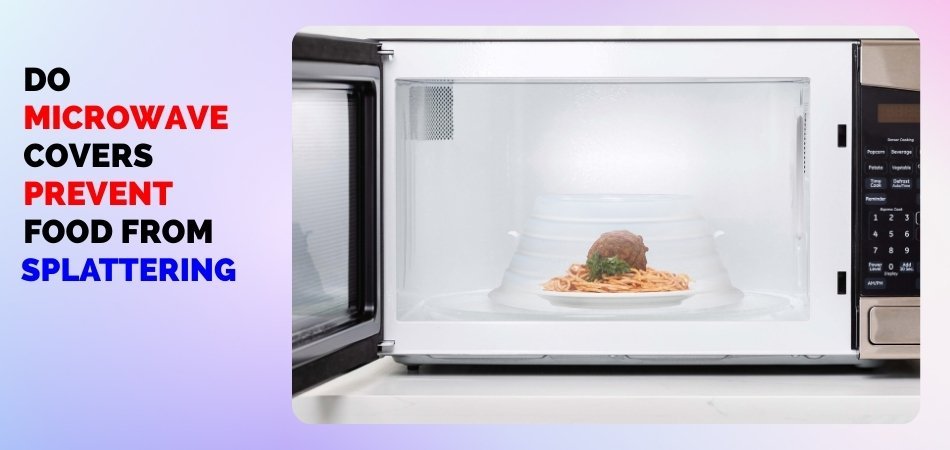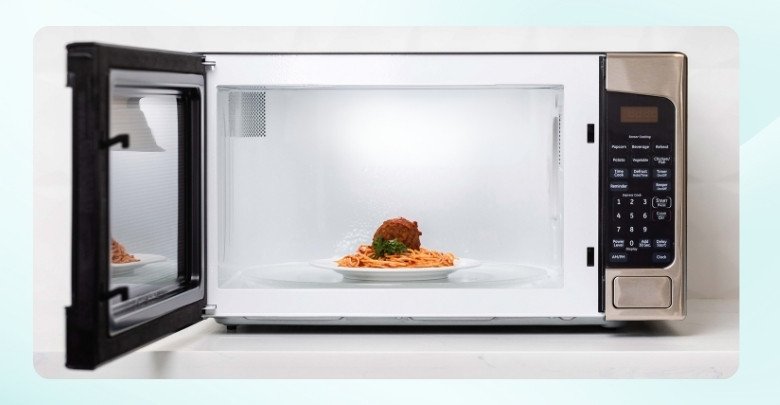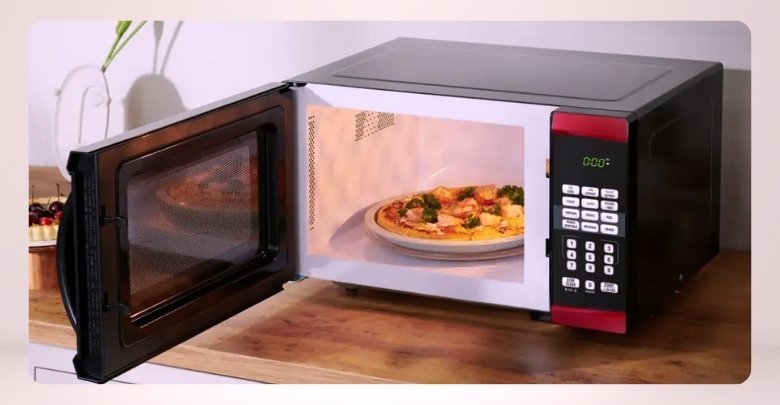Microwaves are an integral part of most kitchens today, providing convenience and speed when preparing meals. However, one common issue many face while using this handy appliance is the mess created by food splattering during cooking. Whether it’s sauce, soup, or leftovers, splatters can make a mess in the microwave and require extra cleanup. This raises the question: Do microwave covers prevent food from splattering?
Yes, microwave covers prevent food from splattering by trapping steam and containing moisture. They block liquids from escaping, reduce mess, and help food heat evenly for better cooking efficiency and cleanliness.
The following section of this article will give you an insight into how you can make your cooking experience cleaner and more efficient by using microwave covers. So don’t stop reading.
Do Microwave Covers Prevent Food from Splattering?
Yes, microwave covers do prevent food from splattering. They help keep the microwave clean by trapping steam and moisture, which stops sauces or liquids from popping and making a mess. The cover also helps food heat more evenly by spreading steam over the surface. Let’s look at how they prevent food from splattering:

Steam Stays Inside
When food heats up, it creates steam that can escape and cause splatters. The microwave cover traps most of that steam. It keeps the moisture inside, helping the food cook more evenly. The cover also prevents the steam from splashing everywhere inside the microwave.
By holding the steam close to the food, the microwave cover helps it cook better and stay moist. This also keeps the microwave clean since less moisture escapes. With the cover, food gets heated evenly without a mess. Trapping the steam creates better cooking results and reduces cleanup time.
Stops Popping Sounds
Heated food, especially sauces, can create loud popping noises in the microwave. These pops happen when food bubbles and splashes out of control. A microwave cover keeps the food contained and prevents it from making a mess. It also stops the popping from causing trouble inside the microwave.
As long as the cover is in place, food cannot burst out and create splatters. This keeps your microwave and kitchen clean. If you want a quieter, cleaner microwave experience, a cover helps prevent the loud popping sounds. This simple tool makes a big difference in how your microwave works.
Covers the splashes
Food tends to splash when it’s heated too quickly, and liquid can fly around the microwave. A microwave cover acts as a shield, keeping splatters from making a mess. It protects the microwave walls from sauce and food spills. Even if the food bubbles up, the cover prevents a mess.
The cover creates a barrier between the food and the microwave walls, so food stays contained. It also prevents sauce or soup from getting all over your microwave. This is especially helpful when heating liquid-based meals like soup or pasta. The cover catches everything, making cleanup easier and faster.
Tiny vent holes
Most microwave covers have small vent holes that help regulate steam and pressure. These holes allow some steam to escape, preventing a build-up of pressure. Without the vents, the cover could pop off or cause a mess. The tiny holes are designed to balance the moisture levels while preventing splatters.
These vents help the microwave cover function without overheating. They allow just the right amount of steam to escape while containing the mess. Even with the vents, the cover still keeps the microwave clean. This makes the microwave cover both efficient and safe to use.
Microwave covers do a great job by stopping splatters and making cleanup easier. Using better and smarter food covers can also help heat food more evenly. One good option is the duo cover, which is made to make cooking in the microwave even easier and cleaner. Give it a try and enjoy mess-free, simple microwave cooking every day.
Common Microwave Mistakes That Lead to Food Splatters
Microwaves are super helpful, but using them the wrong way can turn simple meals into big messes. Most food splatters happen because of small mistakes we don’t even notice. Want to know what these mistakes are? Here’s a list of them:
Overheating Food
Heating food for too long can cause it to boil or explode. This often happens with sauces, soups, or thick liquids. They start to pop and splatter all over the microwave. Check the timer and use short heating intervals. It’s better to reheat in steps than to clean a big mess.
Not Stirring Halfway
Some foods heat unevenly in the microwave. The outside may be hot while the middle is still cold. If you don’t stir halfway, pressure can build up in the middle, causing it to pop. Just a quick stir can help heat things evenly and reduce splatters.
Sealing Containers Tightly
Using a container with a tight lid can be risky. Steam gets trapped inside, and without a way to escape, it can cause the lid to burst off. That leads to a messy microwave and possibly hot food flying out. Always use microwave-safe covers with vents or leave the lid slightly open.
No Cover Used
This is one of the biggest reasons for splatters. When you heat food without a cover, it can bubble and pop everywhere. To stop this from happening, it’s important to cover food properly in microwave so that steam and splashes stay inside. A cover keeps everything in place and blocks those splashes. It’s such a small step, but it makes a huge difference.
Using Small Bowls
Too small a bowl results in food overflowing during heating. This is especially true for liquids like soups or stews. Use a bowl that has some extra space at the top. That way, even if it bubbles, it won’t spill out.
Ignoring Food Type
Not all foods behave the same in the microwave. Things like eggs, sauces, and thick gravies can easily pop if not heated carefully. It’s important to know what kind of food you’re reheating and take small steps to avoid mess. Read instructions if there are any, or start with shorter times.
When Shouldn’t You Use a Food Cover in the Microwave?
Food covers are super helpful in most cases, but there are times when using one might not be the best idea. Using it wrong can sometimes cause more mess or even damage. Want to know when to skip the cover? Let’s explore the situations where it’s better to leave it off.

Cooking Dry Foods
Dry foods like toast, chips, or cookies don’t need a cover. They don’t produce steam or splatter much, so covering them doesn’t really help. In fact, trapping steam with these foods can make them soggy. If you want them to stay crispy, heat them without a cover. That keeps the texture just right.
Using Non-Vented Covers
If your cover doesn’t have small holes or vents, be careful. Steam can build up under the cover and make it pop off suddenly. This can cause spills and even damage the microwave. Always use covers with vents, or leave a small gap for steam to escape. Safety is just as important as keeping things clean.
Reheating Greasy Foods
Foods like bacon or oily leftovers can get super hot fast. If the steam and oil get trapped, it can cause splattering under the cover. This can create a greasy mess inside or even damage the cover. It’s better to use a paper towel or just heat it uncovered for a short time.
Melting Certain Foods
Things like chocolate or cheese melt quickly and don’t really splatter much. Covering them can make them overheat or lose texture. They usually just need a short time to melt and don’t benefit from the steam a cover creates. Keep an eye on them and heat in small steps instead.
Heating Sealed Containers
Sometimes people put a sealed container in the microwave and then cover it again. That’s a bad idea because there’s nowhere for the steam to go. The pressure builds up fast and can cause the lid to burst off. Always make sure there’s enough space for steam to escape.
Very Short Heating
If you’re just warming something for 10–20 seconds, it usually doesn’t need a cover. Quick heating doesn’t give food enough time to splatter. Using a cover in such short times won’t help much and might even be a waste of time. Keep it simple for quick reheats.
Can Any Lid Be Used as a Microwave Food Cover?
No, not every lid is safe to use in the microwave, even if it fits perfectly on your container or bowl. Some lids are made from plastic that melts or warps when heated for a few minutes. Others may not be microwave-safe and can release harmful substances into your food. It’s always best to check if the lid has a “microwave-safe” label before using it.
Microwave-safe lids are made to handle heat without causing problems while your food is cooking or warming up. One good option is silicone covers, but it’s important to check silicone food cover safety in the microwave before using them regularly. Some silicone lids are safe and work really well, while others may not be made for high heat. Just because a lid looks strong doesn’t mean it’s safe for microwave use.
Avoid using metal lids or anything with shiny parts, as they can spark and damage your microwave. Also, don’t use lids that seal too tightly, because steam needs to escape while heating. If steam can’t get out, the lid might pop off, or your food could explode. So, always leave a small gap or use covers with vent holes when heating food.
Top Tips to Store Microwave Food Covers When Not in Use
There is no question that microwave food covers are very useful, but storing them can sometimes be a challenge, especially in a small kitchen. Keeping them neat saves space and avoids damage. Here are simple tips to help you store them the right way.

- Store in a Clean, Dry Place: Always place your microwave cover in a dry spot to prevent moisture buildup. Moisture can cause damage over time.
- Keep Covers Away From Heat Sources: Avoid storing covers near stoves, ovens, or direct sunlight. Heat can warp the material and ruin the cover.
- Stack Covers Properly: If you stack multiple covers, do so gently without applying heavy pressure. This avoids warping and cracking.
- Use a Storage Container: Consider placing covers in a container or drawer to keep them protected. A box prevents covers from getting lost or damaged.
- Check for Stains Before Storage: Before storing, make sure the covers are clean. Stains left on them can become harder to remove later.
- Avoid overcrowding: Don’t crowd microwave covers with too many items. Overcrowding can cause them to bend or become scratched.
- Hang if possible: Some microwave covers come with holes to hang them. This option keeps them off flat surfaces and reduces clutter.
- Use protective covers: For extra protection, use fabric covers or bags when storing silicone lids. This prevents dust and scratches from building up.
FAQs About Do Microwave Covers Prevent Food from Splattering?
The microwave cover may seem like a simple tool, but it has more to offer than people think. Here are some common questions people ask when it comes to using microwave covers the right way.
Are Microwave Covers Dishwasher Safe?
Yes, most microwave covers are dishwasher safe, especially if they’re made from microwave-safe plastic or silicone. Always check the label before washing. Putting them in the dishwasher helps keep them clean, free of leftover grease, and ready to use again quickly.
How Do Microwave Covers Affect Cooking Time?
Microwave covers may slightly reduce cooking time because they trap heat and moisture, making food cook more efficiently. The steam that’s contained under the cover helps heat the food evenly. This means the food will likely heat faster and more consistently.
Can Microwave Covers Be Used in Convection Ovens?
Microwave covers are generally not suitable for convection ovens, as they are designed specifically for microwave use. Convection ovens use dry heat, which could damage the cover. Always check the manufacturer’s instructions to see if the cover is appropriate for use in a convection oven.
Are Microwave Covers Safe for All Types of Plastic Containers?
Most microwave covers are safe to use with plastic containers, as long as the plastic is microwave-safe. However, avoid using covers with containers that are not labeled as microwave-safe, as the plastic could melt or release harmful chemicals when heated.
Why Do Some Microwave Covers Have Vent Holes?
Microwave covers with vent holes allow steam to escape while the food is cooking. These vents prevent the build-up of too much pressure under the cover. They ensure that the cover doesn’t pop off unexpectedly, which would cause a mess or even a potential hazard.
What is the Best Material for a Microwave Food Cover?
Silicone and microwave-safe plastic are some of the best materials for food covers. Silicone is flexible, durable, and heat-resistant, while plastic covers are often lightweight and easy to clean. Both materials are effective at trapping steam and moisture during cooking.
Final Thoughts
Cleaning your microwave is quick and easy with microwave covers. If you’ve ever struggled with the mess of food splattering everywhere, you know how much of a hassle it can be to clean up afterwards. This simple tool can save you a lot of time and effort.
So, do microwave covers prevent food from splattering? Absolutely! They trap steam, keep moisture in, and reduce the mess inside your microwave. By using them, your food heats more evenly, and your microwave stays cleaner.
Next time you’re reheating your meal, don’t forget to use a cover. It’s a quick step that will make your cooking process smoother and your cleanup way easier.






